Microsoft Surface Pro 2 Review
by Anand Lal Shimpi on October 21, 2013 12:01 AM EST- Posted in
- Tablets
- Microsoft
- Mobile
- Surface
- Surface Pro 2
CPU Performance
While multitasking on Surface 2 can struggle, the same really can’t be said for Surface Pro 2. The tablet is effectively a Haswell Ultrabook, capable of delivering the exact same performance as a 2013 MacBook Air – but in the form factor of a thick tablet. The performance of Intel’s Core i5-4200U is a fairly known quantity at this point, but to put Surface Pro 2’s tablet performance in perspective here are some comparisons to the best of the best in the ARM tablet space.
I ran tests using both Chrome and IE11, the latter is really only optimized for SunSpider and horribly unoptimized for everything else. In general you're multiple times better performance than what you can get from a quad-core Cortex A15 based device. If we look at Kraken, Surface Pro 2 running IE11 completes the test in 1/4 the time as Surface 2 running the same browser.
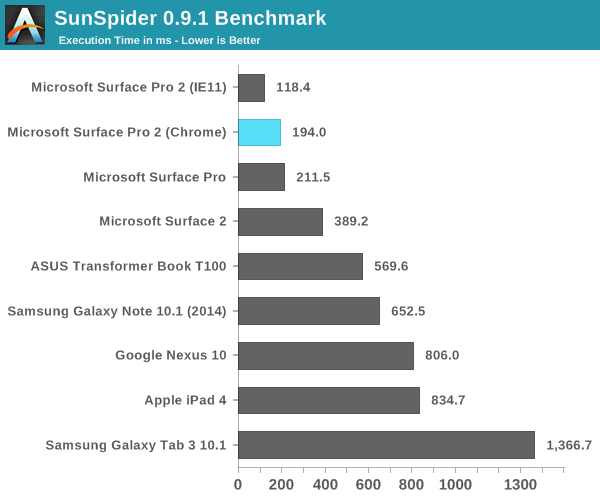
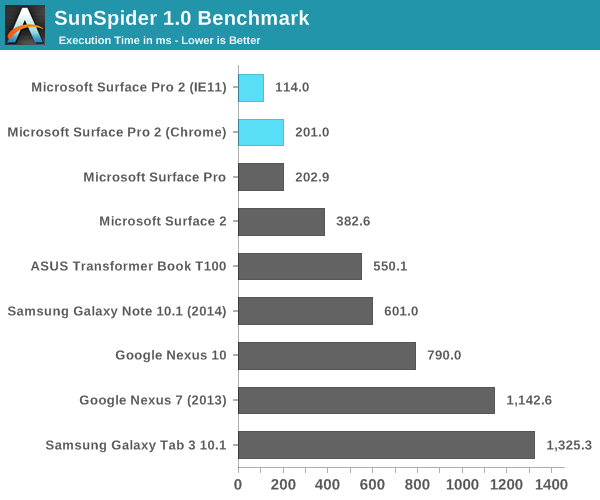


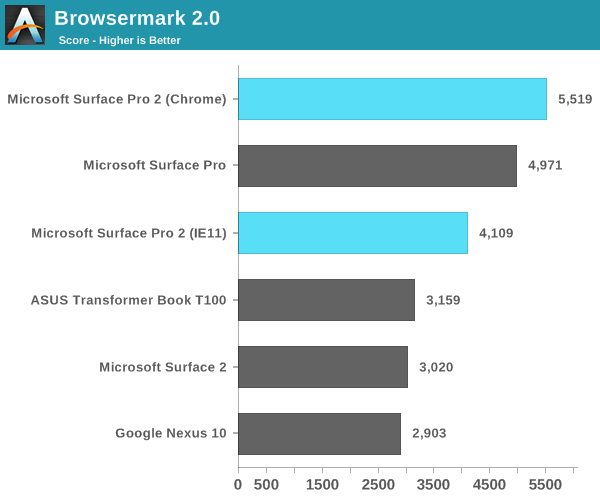
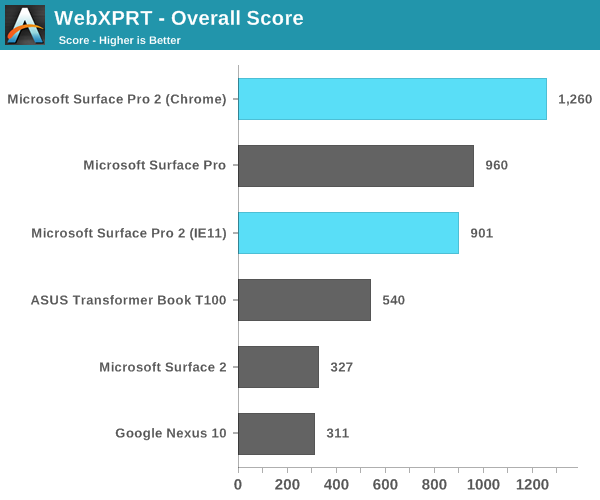
GPU Performance
Intel’s HD 4400 is good enough for light gaming and is a huge step above what you can find in a traditional ARM based tablet. Microsoft only gave us a few days to review both devices so I didn’t have a ton of time to re-characterize the performance of Intel’s HD 4400, but I’ve done that elsewhere already.
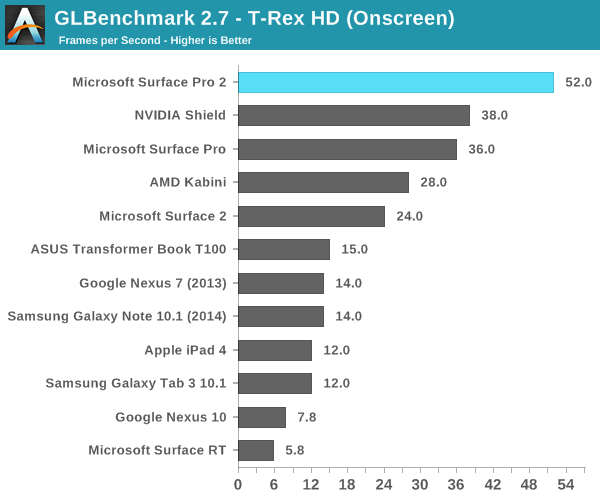
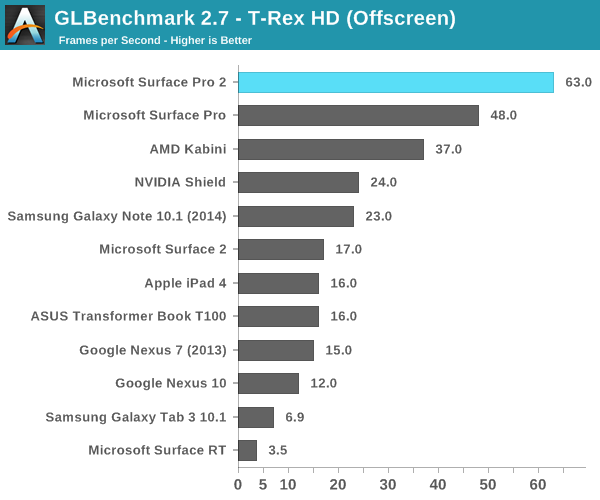
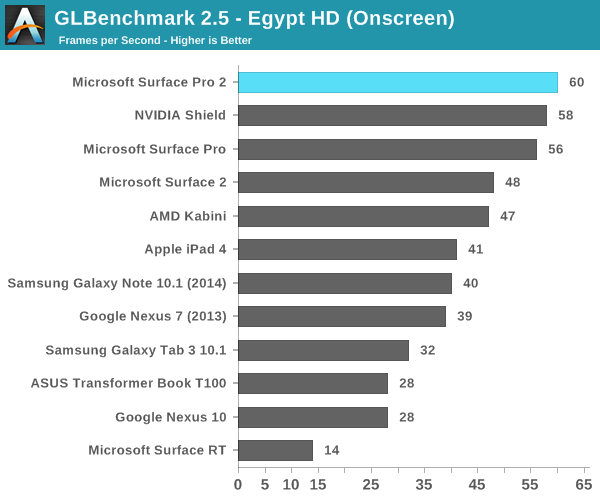
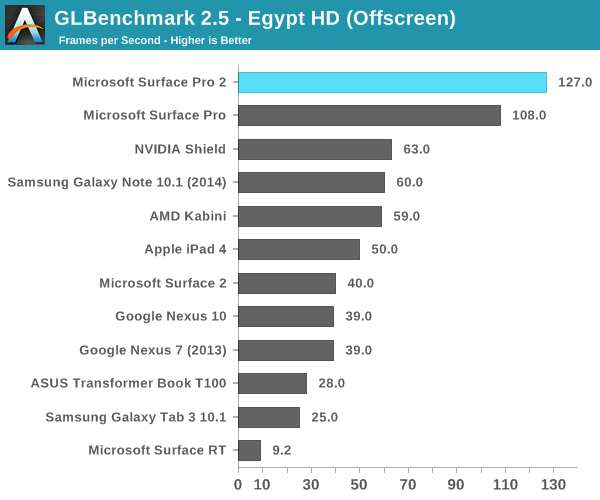
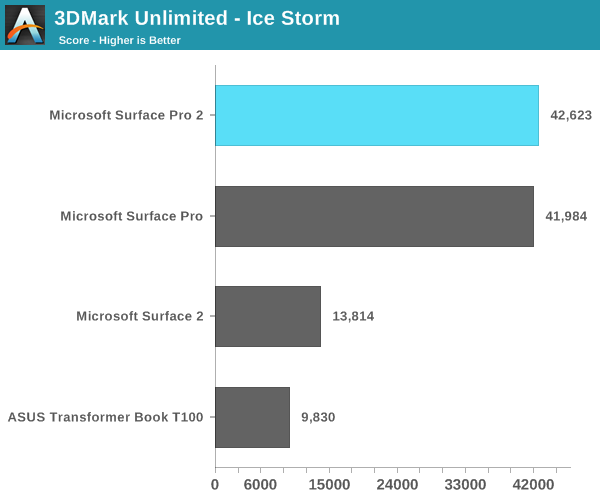
Storage Performance
My review sample appears to have a SK Hynix based SSD. I ran it through the same modified IO tests I did on the ASUS T100:
Our Android IO tests rely on Androbench with a relatively limited LBA span. I increased the difficulty of the test a bit under Windows 8.1 but still kept it reasonable since we are dealing with eMMC solutions. I’m testing across a 1GB LBA span and testing for a period of 1 minute, which is an ok balance between difficulty of workload and sensitivity to the fact that we’re evaluating low-class SSDs here.
Surface Pro 2 is a completely different league of IO performance. The number to pay attention here is the tremendous increase in random write performance compared to the eMMC solutions we’ve tested. I suspect the gap increases if we were to look at worst case sustained random write performance. Killer sequential performance definitely helps Surface Pro 2 feel quick.

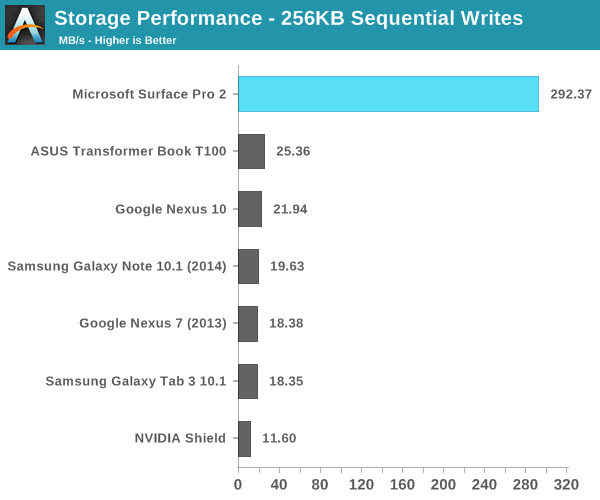
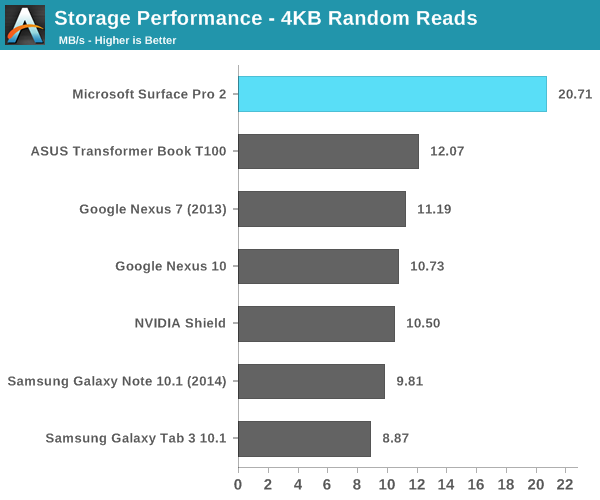











277 Comments
View All Comments
Silma - Monday, October 21, 2013 - link
Complaining about non pcie ssds. Ok in which real case scenario do you see any difference? Isn't it the case that in most real life scenarios it is already impossible to feel the difference between ssds except in very special cases that don't concern most people? Also how fast does the surface pro 2 boot? compare it to other windows & mac notebooks. isnt it the case that it is in fact best in class?willis936 - Monday, October 21, 2013 - link
The storage subsystem has been the single aspect of performance that has been gating consumer devices for the past five years. People don't need hefty CPUs, GPUs, memory bandwidth, or memory capacity when browsing the internet and editing documents. However boot times and program launch times could always be faster and most of the time the rest of the system is twiddling it's thumbs waiting for storage. There's a reason anandtech pushes these things: it's so OEMs will take away what they should focus on to give people better devices.ddriver - Monday, October 21, 2013 - link
USB 3 has decent bandwidth, but its will add to the latency, it will still be orders of magnitude better than a HDD though.dew111 - Monday, October 21, 2013 - link
"Once again Microsoft refuses to equip Surface Pro with a Thunderbolt port, which would help greatly in dealing with high performance storage expansion concerns. There is still a USB 3.0 port at least."So, Thunderbolt and USB 3.0 are both fairly good for external storage. Since this is a tablet, there isn't a whole lot of room for ports. One of these is compatible with literally tens of thousands of devices, with cables starting at ~$2. The other is compatible with literally dozens of devices with cables starting at about $40. Maybe they could have put a Thunderbolt port instead of the miniDP, but then they would have had to pay Intel for an expensive controller chip for a feature that very few people would ever use.
nerd1 - Monday, October 21, 2013 - link
I have TONS of macbook users around and not a single of them ever own any thunderbolt storage. Oh many of them DO own thunderbolt ethernet dongles, hdmi dongles and VGA dongles. :DHave anandtech EVER complained about macbooks not having VGA ports (super important if you do ANY presentation), ethernet port (important for any real work), hdmi port or eSATA ports? Why do they care about the interface NO ONE bothers to use at all?
backbydemand - Monday, October 21, 2013 - link
Thunderbolt VGA? Well that's bandwidth well used.... :-srituraj - Wednesday, October 23, 2013 - link
Agreed. Also, seeing that people are complaining about the price (I too am), it is very likely they will buy a thunderbolt device for whatever reason.eanazag - Monday, October 21, 2013 - link
I have had the Surface Pro since it first came out and I think it is great. That being said, there was a lot of opportunity to improve the device going into the Pro 2. There are some key things that I would have liked to see. Battery life should have improved more since they kept the device the same thickness. I was looking for 8 hours on basic usage (email, word doc, and web browser running). What about cellular and GPS? The Surface Pro and Pro 2 and frankly the Surface 2 do little to compete against the iPad. As a matter of fact I view it as if there is a non-compete clause with Apple. There are too many location based applications and use cases for this size device that I just don't get it. I don't want to carry and charge a hotspot and Bluetooth GPS on top of the Surface Pro.MS is killing me. I can't recommend this at my job for an iPad + laptop replacement because of this. It is a great device. It just seems like no attempt to really attack the market. Nine months for a CPU upgrade and a dock that should have made it to the first party earlier this year. The two position hinge is the only other advancement and Anand gave them the idea last round. I don't see anything here that makes me thinks MS gets it. I just see changes that any MS design team could have gotten from Googling the web for ideas. I am disappointed at what this could have been.
hoboville - Monday, October 21, 2013 - link
You're hitting the nail on the head, it's target audience is people who need mobile productivity. The inclusion of Office has been one of their main selling points (probably the only reason for RT to exist). Compare this though to other tablets and it does seem weird. On one hand it's trying to be a tablet, on the other it's trying to be a PC, but does neither very well.beggerking@yahoo.com - Tuesday, October 22, 2013 - link
for god sake, if you've never used the device, stop saying that it doesn't work well ..because the truth is , it works well enough both as a tablet or as a pc.